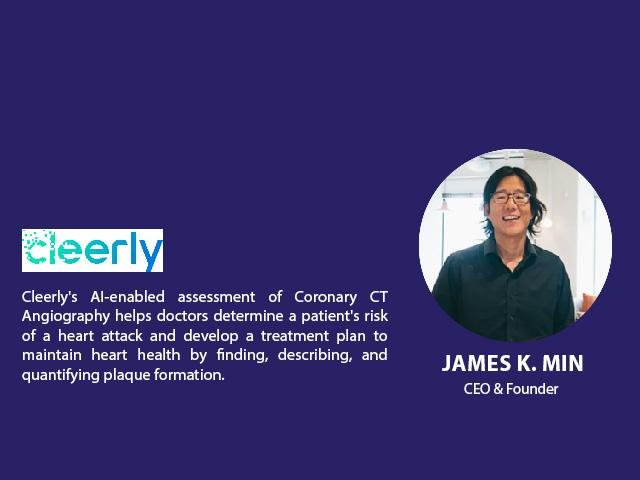Cleerly goes above and beyond the conventional methods of diagnosing heart disease by thoroughly evaluating each coronary artery and branch.
Cleerly’s AI-enabled assessment of Coronary CT Angiography helps doctors determine a patient’s risk of a heart attack and develop a treatment plan to maintain heart health by finding, describing, and quantifying plaque formation.
Health Based on Specialization and Precision
Cleerly’s technique quantifies and characterizes coronary artery disease (CAD) to help tailor therapies to a patient’s actual state rather than using indirect indicators like surrogates, symptoms, and disease sequelae as has historically been done. Additionally available are cutting-edge digital and print solutions from Cleerly that convert difficult imaging data into therapeutic insights that clinicians and their patients can use.
For more than 50 years, cardiology has largely been “sick-care,” with a focus on the symptoms and indicators of atherosclerosis-related heart disease rather than the disease itself. The most crucial element, according to data from clinical trials conducted over a ten-year period, is the kind of atherosclerotic plaque buildup. Instead of waiting for reduced blood flow or clogs, it’s time to address the problem head-on, diagnose the underlying condition, and accurately treat it.
Cleerly’s analysis carefully assesses all of your coronary arteries and branches. determines your risk of having a heart attack and helps your doctor select the best course of treatment to keep your heart healthy by identifying, describing, and precisely counting plaques.
True Visionary at the Core
James K. Min, MD, is a former radiology and medicine professor at Weill Cornell Medical College as well as the former head of the New York-Presbyterian Dalio Institute of Cardiovascular Imaging (ICI). His clinical interests are on cardiovascular imaging and cardiovascular disease prevention. He is a doctor of cardiology with board certification.
With a clinical and scientific focus on coronary artery disease, Min has created more than 500 peer-reviewed articles, some of which were funded by several grants from the National Institutes of Health and the Dalio Foundation. The notable multicenter clinical investigations and registries on which Min has served as the primary investigator include the ACCURACY, CONFIRM, CONSERVE, CREDENCE, ICONIC, and PARADIGM trials. Additionally, Min is in charge of a state-of-the-art coronary computed tomography core lab for numerous multicenter clinical trials, such as the PACIFIC and ISCHEMIA trials.
Min has the opportunity to use the vast clinical trial research he has been performing for the past 17 years to the development of brand-new, as-yet-unavailable remedies for coronary heart disease through the invention, approval, and distribution of Cleerly’s goods and services. Min graduated from Temple University Medical School with a medical degree after earning a BA from the University of Chicago. At the University of Chicago Hospitals, he finished his internship, residency, and cardiovascular medicine fellowship.
Assessing Actual Disease
Sudden coronary death from fatal heart attacks has remained the world’s top cause of mortality and morbidity for the past 50 years, with a death from cardiovascular disease occurring every 1.7 seconds.
Previously, Cleerly has focused on disease surrogates (like cholesterol), disease symptoms (such chest pain or shortness of breath), or disease aftereffects (like ischemia or stenosis). The majority of coronary lesions that cause heart attacks, nevertheless, are silent, go unnoticed, and don’t lead to ischemia or stenosis. It’s time to measure actual disease rather than just indications of disease.
Atherosclerotic plaque in the arteries can be located and measured using Cleerly technology, revealing both its amount and kind. The best classifier of future heart attack risk and the most reliable predictor of your patient’s propensity to encounter an impending cardiac event is plaque type, according to research. High-risk plaques have been stabilized by transitioning from non-calcified fatty plaques to calcified stable plaques through dietary changes and medical treatment. It has been shown that the incidence of severe adverse cardiovascular events is reduced when non-calcified high-risk plaques are calcified.
Digital Care Transformation Pathway
For the assessment and treatment of coronary artery disease, Cleerly provides a revolutionary digital care pathway (CAD). Cleerly’s solutions examine CAD thoroughly and quantitatively using the most recent artificial intelligence (AI) frameworks, and they provide clinical solutions to imaging doctors, clinicians, and patients.
- Change in care paradigm from symptom-driven to risk-based: A New Standard of Care.
- End-to-end AI-based approach to transforming imaging research into practical therapeutic insights is called “Transforming Images Into Intelligence.”
- Innovative Patient-Specific Education: New technologies that make it possible for a patient to see their own disease in order to improve therapeutic adherence and collaborative decision-making.
- Only way to personalize treatment to a patient’s real disease features is through phenotype-driven personalized medicine.
- Only way to directly measure illness development or stabilization over time, and to inform adjustments to medical therapy, is by direct non-invasive disease tracking.
Cleerly creates ground-breaking technology every day that transforms how heart attacks and other cardiovascular disorders are treated and prevented. Cleerly invests a significant amount of time and money in research and development to achieve this. In order to protect the technologies that have helped Cleerly become the market leader in the detection and treatment of cardiovascular disease, the firm has worked hard to build a solid intellectual property portfolio.

